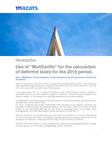
Use of "Multitariffs" for the calculation of deferred taxes for the 2016 period.
With the enactment of Law 1819 of 2016, changes were introduced, among others, in the income tax rates applicable to legal entities. Such rates were set at 34% with a 6% surtax (year 2017); 33% with a 4% surtax (year 2018) and 33% (year 2019 onwards).
In accordance with IAS 12 or Section 29 "Income Taxes", deferred taxes must be restated in accordance with the tax rates expected to apply in the period in which the asset is realized or the liability is settled. For this purpose, the rates described above should be considered.
The application of deferred taxes is not common practice for national accountants, although they were required under Decree 2649 of 1993.
For those companies that already implemented IFRS according to the adoption schedules, the calculation of deferred taxes was generally based on the tax rates in effect in the 2014 and 2015 periods (or any other applicable rate for free zones or occasional gains, for example), which corresponded to 34% (25% associated to income tax and 9% to CREE tax).
With the introduction of graduated and progressive rates, the estimation of current tax and deferred tax will not have the same rates. This happens basically because the temporary differences will not necessarily be realized or cancelled at the 34% rate, but the current tax of 2016 will.
Likewise, Law 1429 of 2010, for having a special rate regime during its application period, presents the same situation of "Multi Rates" and applicability as the Tax Reform.
For example, if a property, plant and equipment is depreciated with a tax useful life of 10 years and 20 years for the technical accounting frameworks in force, the depreciation of the period will be different, and as a consequence a deferred tax liability will be recognized, because the current tax payment will be lower with respect to the tax that could have been paid based on financial results.
Therefore, it is important to determine the most appropriate rate when there are multiple tax rates over a time horizon. The way to estimate this rate is by using a tax projection per fiscal year, according to the respective tax rates and dividing this amount by the total of the original item to be deducted or taxed. By using this rate, an accurate deferred tax asset and liability is obtained until the moment when the temporary difference is eliminated and becomes zero.


